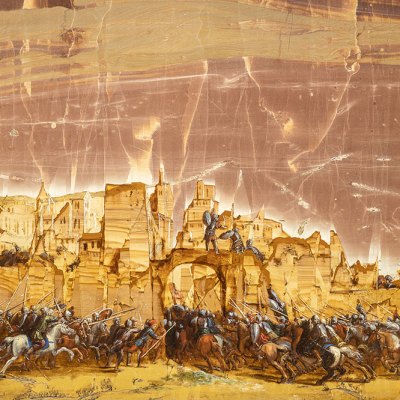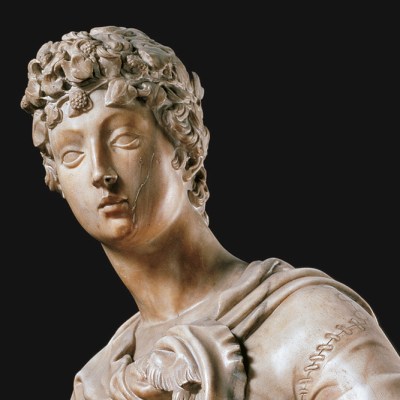So often in great Italian churches your eye is drawn upwards and heavenwards to fresco decorations. Siena Cathedral offers in addition a quite different spectacle: its extraordinary inlaid marble floor. The floor is covered for much of the year for conservation reasons – but for a few weeks in the summer and early autumn (this year, until 18 October) it is revealed to the public in all its glory. A compendium of artistic innovations, it was designed chiefly by local artists from the mid 14th to the mid 16th century and eventually came to cover 1,300 square meters. Like so many of Siena’s artistic wonders, the creation of the floor was an exercise in civic pride. But it was also intended as a display of humanist knowledge: a great visual book or carpet in stone that invites decoding.
The marble floor of Siena Cathedral. Photo: Bruno Bruchi Siena/Fabio and Andrea Lensini, Siena; courtesy Archivio fotografico dell’Opera della Metropolitana di Siena, Aut. n. 264/2023

The palette chosen for the marbles is not wide-ranging, but it is nonetheless rich, featuring the colours of liquorice, chestnut, toffee, honey and cream. It is as though a vast series of chiaroscuro woodcuts have been laid out for appraisal, the forms of which seem to shift and oscillate as shafts of sunlight from the high windows move around the building.
Ground plans of the cathedral created in the 19th century and modern photography from above provide crisp legibility of a sort that would never have been available to Renaissance worshippers or indeed the artists who ingeniously devised the decoration of the floor. Wandering around to gradually decipher the narratives – looking across them at an oblique angle from normal viewing height – is a closer experience to theirs and a delightful albeit complex process of discovery. The subjects depicted in marble are all oriented to be read as you progress through the cathedral from the main door, along the nave and aisles towards the high altar. In very broad terms they can be seen as laying out a gradual process of revelation and acquisition of knowledge. It is not, though, a rigidly sequential scheme, rather an anthology of themes which mirror late medieval and Renaissance learning about the ways that aspects of Christianity were prefigured. So you chiefly encounter sibyls and prophets, allegories and Old Testament narratives, all enclosed in intricate decorative borders.
The local artists who contributed to this vast project included Sassetta, Domenico di Bartolo, Matteo di Giovanni, Neroccio di Bartolomeo de’ Landi, Francesco di Giorgio Martini and Domenico Beccafumi. The Umbrian painter Pinturicchio, who created the stunning frescoes in the nearby Piccolomini Library, also devised a key scene on the floor, Allegory of the Mount of Wisdom-Happiness (1506), which depicts the testing path to Virtue. It is one of the most rewarding and best-preserved contributions to the pavement.
Allegory of the Mount of Wisdom-Happiness (1506), Pintoricchio. Siena Cathedral. Photo: Bruno Bruchi Siena/Fabio and Andrea Lensini, Siena; courtesy Archivio fotografico dell’Opera della Metropolitana di Siena, Aut. n. 264/2023

Fortune (at the lower right) has succeeded in landing some sages or wise men on a rocky island. They gradually climb, passing snakes and other reptiles, attempting to reach the seated figure of Wisdom. She sits between philosophers and offers a palm of victory to Socrates and a book to Crates of Thebes, who dispenses with his material wealth, pouring jewels into the sea. The analysis of such rich and allusive imagery has been hugely assisted by the publication of a new study called A Book of Marble by Marilena Caciorgna from Siena University, which provides a detailed account of the floor’s complex iconography.
The Hellespontic Sibyl (1483), Neroccio di Bartolomeo de’ Landi. Siena Cathedral. Photo: Bruno Bruchi Siena/Fabio and Andrea Lensini, Siena; courtesy Archivio fotografico dell’Opera della Metropolitana di Siena, Aut. n. 264/2023

As well as offering subjects to decipher, the pavement also presents a broad overview of the stylistic evolution of Sienese art across the centuries. As you move through the cathedral, you progress chronologically in terms of when elements of the scheme were added. Initially, a visitor encounters statuesque and emblematic figures, notably sibyls, in the inlays conceived by Neroccio di Bartolomeo de’ Landi. Later, intricate narratives appear, such as Matteo di Giovanni’s Massacre of the Innocents – a scene of devastation ingeniously set within the carefully articulated space of a Renaissance hall. Finally, spectacles like the intensely crowded Stories of Moses on Mount Sinai by Domenico Beccafumi transport you to a world of mannerist complexity. This is indebted to works by Raphael, while offering a profusion of figures and invention perhaps at the expense of legibility.
Stories of Moses on Mount Sinai (1531), Domenico Beccafumi. Siena Cathedral. Photo: Bruno Bruchi Siena/Fabio and Andrea Lensini, Siena; courtesy Archivio fotografico dell’Opera della Metropolitana di Siena, Aut. n. 264/2023

The current unveiling, coinciding with the publication of the new scholarly assessment of the floor, provides an ideal opportunity to seek virtue and wisdom – if you wish, that is. Alternatively, you might just enjoy the considerable and seductive visual appeal of such an inventive and sustained artistic endeavour.
The inlaid marble floor of Siena Cathedral is unveiled until 18 October. A Book of Marble: The Pavement of Siena Cathedral by Marilena Caciorgna is published by Sillabe Livorno.


